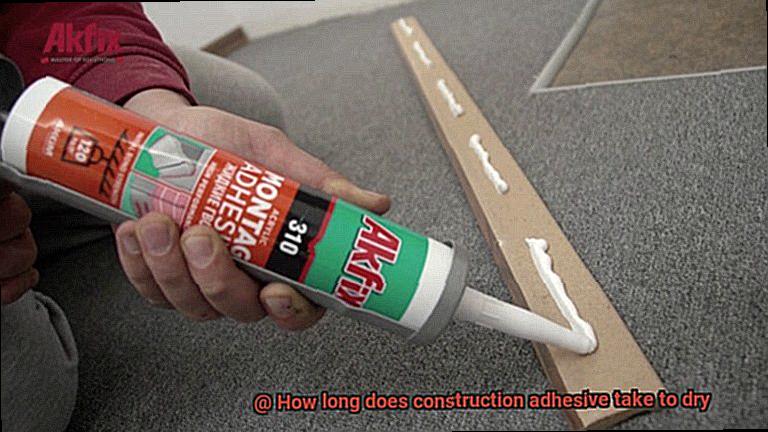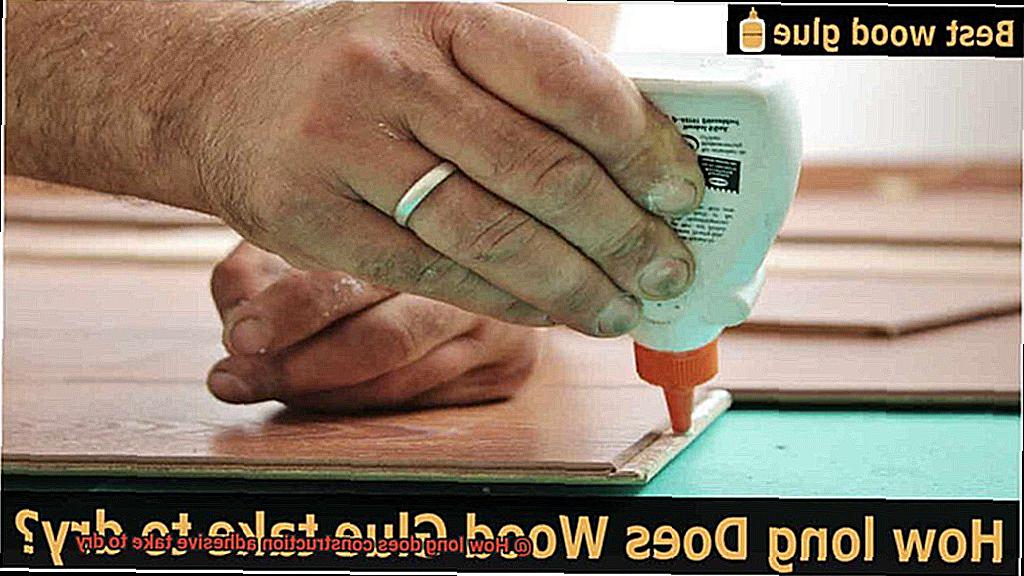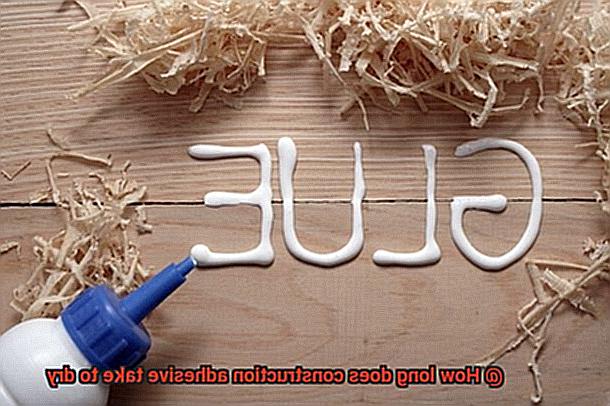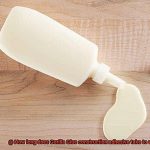Are you knee-deep in a home improvement project and itching to know how long that construction adhesive will take to dry?
Well, look no further. Whether you’re sticking tiles on a backsplash or securing baseboards like a pro, the drying time of construction adhesive is key.
You don’t want to ruin your masterpiece by prematurely moving or applying pressure. In this blog post, we’ll dive into the captivating world of construction adhesives and uncover their drying secrets.
So buckle up and get ready for an adhesive adventure.
What is Construction Adhesive?
Contents
When it comes to construction projects, construction adhesive is the unsung hero, providing the strong bonds that hold structures together. In this article, we will explore the world of construction adhesive, uncovering its key characteristics and the multitude of applications for which it can be used.
The Strength Within:
Construction adhesive is renowned for its ability to provide a robust and durable bond. Unlike traditional glue, it is specially formulated to withstand heavy-duty applications, extreme temperatures, vibrations, and even some degree of movement without compromising its adhesive properties. Whether you’re securing wood, metal, concrete, or plastic, construction adhesive ensures a powerful connection that stands the test of time.
Versatility Amplified:
One of the greatest advantages of construction adhesive is its versatility. From installing drywall to securing flooring materials, attaching baseboards or crown molding, and even bonding heavy objects like countertops or cabinets, this adhesive can handle it all. Its strong bond ensures that materials stay securely in place, providing stability and durability for any construction project.
Curing Time Matters:
Understanding the drying and curing time of construction adhesive is critical for achieving maximum bond strength. While initial drying may take 24 hours, complete curing can take several days or even weeks.
It is essential to follow the manufacturer’s instructions regarding drying and curing times to ensure optimal results. Rushing the process can compromise the bond strength and longevity of the adhesive.
Factors Affecting Drying Time:
Several factors influence the drying time of construction adhesive, including temperature, humidity, ventilation, and the type of materials being bonded. Higher temperatures and lower humidity levels generally lead to faster drying times. Adequate ventilation not only helps expedite drying but also ensures a safer working environment by minimizing exposure to potentially harmful fumes.
Tips for Success:
To expedite the drying process, apply construction adhesive in a well-ventilated area with proper air circulation. Consider clamping or providing additional support for heavier materials during the drying period. Always wear protective gloves and avoid touching uncured adhesive to prevent messy mishaps. Following these tips will help you achieve strong bonds and long-lasting results.
Factors Affecting Drying Time
Today, we embark on a journey into the mysterious realm of drying time and unravel the intricate factors that hold sway over this enchanting process. Prepare to be captivated by the secrets that lie within as we delve into the art of patience and master the dance of adhesive drying.
The Tapestry of Adhesive Types:
Let us first explore the tapestry of adhesive types. Like a symphony of chemistry, construction adhesives come in different flavors – solvent-based, water-based, and hybrid adhesives. Each type possesses its own unique composition, intricately influencing the drying time. Choose wisely, for it is this choice that sets the tempo for your adhesive masterpiece.
Nature’s Whimsical Interplay:
Picture this: you stand poised, ready to fuse two pieces together when nature’s whimsical interplay sweeps in. Temperature, humidity, and airflow become supporting actors in this drama of drying time. A higher temperature and lower humidity levels hasten the process, while cooler temperatures and higher humidity levels tease out patience. Fear not, brave craftsmen. By understanding nature’s choreography, you can sway her to your rhythm.
The Substrate Symphony:

Not all surfaces are equal partners in the dance of adhesive drying. Porous materials like wood or concrete thirstily absorb moisture, elongating drying time with their insatiable desire. Conversely, non-porous materials like plastic or metal sip lightly from the adhesive fountain, drying with haste. When selecting your adhesive duet, harmonize with your substrate to achieve a masterpiece without delay.
Thickness: The Maestro’s Baton:
The thickness of your adhesive application wields great power over drying time. Like a conductor’s baton, it sets the pace for the symphony of evaporation. A thicker layer, reminiscent of a grand opus, requires more time for moisture to dissipate, elongating the drying process. Heed the composer’s instructions, and avoid drowning your creation in an excess of adhesive, unless a watery symphony is your desired finale.
The Dance of Drying and Curing:
Let us dispel a common misconception: drying time and curing time are not one and the same. Drying time marks the moment when the adhesive achieves a solid state, but may not have reached its full strength yet.
It is during this duration that the adhesive flexes its muscles, reaching its maximum strength and bonding fully with the substrate. Embrace patience, for it is the key to a lasting bond.
Temperature and Humidity
Well, behold the secrets of temperature and humidity, the enchanting duo that holds the power to dictate the pace at which your adhesive sets and bonds.
Let us begin with temperature, for even construction adhesive has its own temperature preferences. Like a creature of habit, higher temperatures hasten the drying process, while lower temperatures coax it into a leisurely rhythm. Yet, take heed, extreme temperatures can send the adhesive into a state of disarray, disrupting its performance. Thus, finding the delicate equilibrium is key.
Picture yourself amidst a summer scorcher or a desert expanse. In these arid and torrid realms, construction adhesive springs to life with an almost supernatural speed. The searing heat and parched air act as catalysts, propelling your project towards swift completion. Should time be your relentless adversary, these fiery conditions shall be your valiant allies.
But lo and behold, if your endeavor unfolds during the icy clasp of winter or within realms cloaked in humidity’s embrace, prepare for a prolonged journey. The frigid chill and watery mist that permeate these domains conspire against you, delaying the adhesive’s drying process. Their malevolence lies in high humidity, for it smothers the adhesive’s yearning to evaporate water, extending its time to set.
To wield optimal drying conditions as your steadfast companions, meticulous monitoring of temperature and humidity becomes paramount. Employ the trusted guardians of thermometer and hygrometer to track these elusive factors. Armed with this knowledge, you shall navigate time’s treacherous waters and determine the precise duration for your construction adhesive’s transformation.
Sometimes, however, additional measures may be required to mold the perfect drying haven. In high humidity realms, where moisture hangs heavy in the air, extra airflow may need to be summoned or dehumidifiers enlisted to hasten the adhesive’s metamorphosis.
Remember, dear adventurer, the manufacturer’s instructions bear wisdom too profound to ignore. They shall reveal the temperature and humidity requirements specific to your chosen brand or type of construction adhesive. Honor these guidelines, for they are the key to forging bonds that withstand the trials of time and ensure the strength of your masterpiece.
Ventilation
Today, we delve into the unsung hero of the drying process: ventilation. Join us as we unravel the mysteries behind achieving that flawless bond. Are you ready? Let’s dive in.
The Great Evaporation Game:
Imagine this: you’ve just applied your construction adhesive, and now it’s time for it to dry. But wait. Without proper ventilation, trapped moisture can delay the drying process and weaken the bond. Fear not, for ventilation comes to the rescue. Adequate airflow helps evaporate moisture from the adhesive, ensuring a quick and efficient drying process.
Bidding Farewell to VOCs:
Did you know that construction adhesives release volatile organic compounds (VOCs) into the air? Though most adhesives have low VOC emissions, proper ventilation is crucial to prevent these compounds from accumulating in enclosed spaces. Fresh air circulating through ventilation systems carries away VOCs, creating a healthier environment during drying.

Temperature Matters:
Heat can be a friend or foe when drying construction adhesives. Excessive heat can interfere with curing and lead to suboptimal results. Fortunately, ventilation regulates temperature by preventing heat buildup. So, open those windows or crank up those fans to create the ideal drying conditions for your adhesive.
Adhesive-Specific Ventilation:
Different types of construction adhesives may have specific ventilation requirements. Some may need more airflow, while others require less depending on formulation and intended use. Always consult the manufacturer’s instructions for precise information on ventilation needs.
Materials Being Bonded
In the world of construction, the bond between materials is the glue that holds everything together, quite literally. But have you ever wondered why some adhesives dry in a flash, while others seem to take an eternity? The answer lies in understanding the properties of the materials being bonded. In this article, we will delve into the fascinating world of materials being bonded and explore the various factors that influence drying time.
Porous vs. Non-porous Surfaces:
The porosity of materials is a critical factor in determining drying time. Porous surfaces like wood or concrete absorb more adhesive, leading to longer drying times. In contrast, smooth and non-porous surfaces such as glass or metal do not readily absorb adhesive, resulting in faster drying. When working with different materials, it is essential to consider their porosity and adjust expectations accordingly.
Moisture Content:
The moisture content of materials also plays a crucial role in adhesive drying time. Some adhesives rely on moisture as a catalyst for curing, meaning materials with higher moisture content may dry faster. Conversely, materials with low moisture content may require additional time for proper drying. Thus, evaluating and accounting for the moisture levels of the materials involved is vital.
Compatibility with Adhesives:
Not all adhesives are created equal; some are specifically formulated for certain materials. Using an adhesive that is compatible with the materials being bonded ensures better bonding strength and quicker drying times. It is imperative to follow manufacturer guidelines and recommendations to achieve optimal performance.
Ambient Conditions:
While the characteristics of the materials being bonded are crucial, ambient conditions cannot be overlooked. Higher temperatures and lower humidity levels generally result in faster drying times, while colder temperatures and higher humidity can slow down the process. Considering the surrounding environment is crucial when estimating drying times.
Manufacturer’s Instructions
Brace yourself for a journey into the realm of glue, where precision and technique reign supreme. So grab your gear and let’s embark on this adhesive adventure.
Drying Time Matters:
Picture this: you’ve meticulously applied your adhesive, but impatience gets the best of you. You ignore the recommended drying time, hoping for a quick fix. Big mistake. The manufacturer’s instructions hold the secret to achieving a bond that can withstand the test of time. By embracing patience and allowing the adhesive to reach its full strength, you ensure a connection that’s as solid as a rock.
Ideal Conditions for Optimal Drying:
Ever felt frustrated when your adhesive takes forever to dry? Don’t blame the glue just yet – it might be craving the perfect environment. Enter the manufacturer’s instructions, your trusty guide to unlocking lightning-fast drying times. These instructions reveal the ideal temperature, humidity, and ventilation requirements, turning your workspace into an adhesive oasis. With these conditions in place, you’ll witness the magic unfold as your adhesive bonds like never before.
Tips and Precautions:
Unlocking the true potential of construction adhesive requires more than just following basic instructions. The manufacturer’s wisdom is at your fingertips, providing invaluable tips and precautions to take your adhesive game to new heights. Want to apply pressure like a pro? The instructions have got your back. Worried about activities that could sabotage your bond? Fear not – the instructions act as your adhesive guru, guiding you towards success.

Subpar Bonding? No Thanks.
Imagine pouring your heart and soul into a project only to have it fall apart due to subpar bonding. Avoid heartbreak by heeding the manufacturer’s instructions. These instructions are the secret sauce that ensures your adhesive stands the test of time. By following them diligently, you create a connection that’s strong, reliable, and built to last.
Warranty Woes:
Did you know that ignoring the manufacturer’s instructions could leave you high and dry when it comes to warranties and guarantees? It’s true. By neglecting these instructions, you not only compromise the performance of your adhesive but also risk losing any recourse if things go awry. So, take a moment to read those instructions carefully – it’s a small investment that safeguards your project and grants you peace of mind.
Additional Support and Clamping
The world of construction adhesive is a fascinating one, filled with opportunities for creativity and innovation. But to truly unlock the potential of these powerful adhesives, it’s important to understand the crucial role of additional support and clamping techniques. These two elements are like the dynamic duo, working together to ensure a strong and lasting bond.
First and foremost, providing additional support is essential when working with construction adhesive. It’s like giving your materials a warm hug, keeping them in place while the adhesive does its magic. Braces and props are the superheroes of this process, holding everything in position and preventing any unwanted movement or shifting that could jeopardize your bond. So remember, always give your materials that extra love and support they deserve.
Now let’s talk about clamping, the secret weapon of the adhesive world. Clamps are like the powerhouses that hold everything together, applying pressure to create a tight bond. Just like there’s a superhero for every situation, there’s a clamp for every job. Whether it’s C-clamps, bar clamps, pipe clamps, or spring clamps, each one has its own unique powers and purpose. So choose wisely and let these clamping champions do their work.
Patience is key when it comes to drying time. Different construction adhesives have different requirements, so always consult the manufacturer’s instructions for guidance. In general, you’ll want to keep those supports and clamps in place for at least 24 hours to give your bond the best chance of success. It may seem like a long wait, but trust me, it’s worth it.
During this drying period, it’s crucial to avoid any unnecessary movement or disturbance. Even the tiniest shift can weaken your bond and leave you feeling stuck (pun intended). So be gentle, be cautious, and let that adhesive work its magic undisturbed.
And for those challenging projects with heavy or vertical materials, don’t forget to use additional supports or bracing systems. These extra precautions will keep everything aligned and under control while your adhesive dries. Think of them as the safety net, ensuring that nothing goes awry during the bonding process.
Handling Cautions During Drying Process
Construction adhesive is a powerful tool that bonds materials together with incredible strength. However, to achieve optimal results, it is crucial to handle the drying process with care. In this article, we will explore key cautions to consider during the drying process of construction adhesive.
Ensure Adequate Ventilation:
Ventilation is paramount when working with construction adhesive. Volatile organic compounds (VOCs) found in adhesives can be harmful if inhaled in high concentrations. To safeguard your health, work in a well-ventilated area. Open windows or use fans to facilitate fresh air circulation and remove potentially harmful fumes.
Protect Yourself with Personal Protective Equipment (PPE):
When handling construction adhesive, prioritize personal safety by wearing appropriate PPE such as gloves, safety goggles, and a mask. Shield your skin, eyes, and respiratory system from contact or inhalation of the adhesive.
Avoid Skin Contact:
Construction adhesive’s strong adhesive properties make it challenging to remove from the skin. Prevent skin irritation and potential allergic reactions by avoiding direct contact with the adhesive. If accidental contact occurs, promptly wash the affected area with soap and water.
Follow Proper Application Techniques:
To ensure even and effective drying, adhere to the manufacturer’s instructions for proper application techniques. Using too much or too little adhesive can impact drying time and bonding strength. Employ recommended tools such as notched trowels or caulking guns for precise application.
Consider Temperature and Humidity:
Factors like temperature and humidity significantly influence drying time. Higher temperatures accelerate drying, while colder temperatures may prolong it. Similarly, high humidity levels slow down drying time. Account for these factors when planning your project and allow sufficient time for the adhesive to dry based on prevailing conditions.
Avoid Disturbing the Bonding Surface:
Once construction adhesive has been applied, refrain from disturbing or moving the bonding surfaces until the adhesive has fully dried. Premature movement can compromise the bond and result in weaker adhesion. Utilize temporary supports or clamps to hold materials in place until the adhesive has cured.
Promptly Clean Up Excess Adhesive:
After completing your project, swiftly clean up any excess adhesive. Construction adhesives are challenging to remove once dried, so wipe away any excess with a damp cloth or sponge before it hardens.
QOWxLIfeFYs” >
Conclusion
Construction adhesive drying time can vary depending on various factors such as temperature, humidity, and the type of adhesive used.
On average, it takes around 24 to 48 hours for construction adhesive to fully dry and cure. However, it’s important to note that this is just an estimate and the actual drying time may vary.
It’s always best to refer to the manufacturer’s instructions for specific guidance on drying times. In some cases, the adhesive may appear dry on the surface but still require additional time to fully cure internally.
Rushing the drying process can lead to compromised bond strength and potential project failures.





